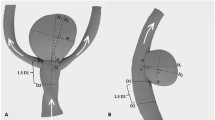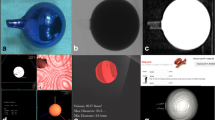Abstract
The purpose of this study is to evaluate the association of the location and geometric parameters of intracranial aneurysm with the risk of rupture. A retrospective study consisted of 284 patients diagnosed with saccular intracranial aneurysm between January 2009 and May 2013 at Wuxi Third People’s Hospital was conducted. 3D digital subtraction angiography images from all patients (240 ruptured, 44 unruptured) were obtained and analyzed. The location of the aneurysms and the 3D geometric parameters including the aneurysm depth, the neck size, diameter of the parent artery, aneurysm angle, aspect radio, size ratio, and the neck-to-parent-artery ratio (NPR) were compared between ruptured and unruptured groups. Results: In ruptured group, anterior communicating artery, posterior communicating artery (PCoA), and the bifurcation of internal carotid artery (ICA) were the top three locations for aneurysm occurrence, accounting for 40.00, 30.42, and 12.08 % respectively. While in the unruptured group, top three locations were PCoA (36.36 %), posterior cerebral circulation (18.18 %), and the bifurcation of the ICA (15.91 %). Distribution of aneurysm location is significantly different (p < 0.05) between ruptured and unruptured aneurysms. For the 3D geometric parameters characterizing aneurysm, aneurysm depth (p < 0.05), parent artery diameter (p < 0.05), aneurysm angle (p < 0.01), aspect ratio (p < 0.01), and size ratio (p < 0.01) all showed a significant difference between ruptured and unruptured group. No difference was found in the neck size and the NPR ratio between the two groups. 3D geometric parameters such as aneurysm depth, parent artery diameter, aneurysm angle, aspect ratio, and size ratio can be helpful in evaluating the rupture risk of saccular intracranial aneurysm for a better prevention and prognosis.
Similar content being viewed by others
References
Azuma, T., Yamaguchi, K., Iida, T., et al. (2007). MR virtual endoscopy for biliary tract and pancreatic duct. Magnetic Resonance in Medical Sciences, 6(4), 249–257.
Baharoglu, M. I., Schirmer, C. M., Hoit, D. A., Gao, B. L., & Malek, A. M. (2010). Aneurysm inflow-angle as a discriminant for rupture in sidewall cerebral aneurysms: Morphometric and computational fluid dynamic analysis. Stroke, 41, 1423–1430.
Chowdhury, T., Cappellani, R. B., Sandu, N., et al. (2013). Perioperative variables contributing to the rupture of intracranial aneurysm: An update. Scientific World Journal, 2013, 396404.
Dhar, S., Tremmel, M., Mocco, J., Kim, M., Yamamoto, J., et al. (2008). Morphology parameters for intracranial aneurysm rupture risk assessment. Neurosurgery, 63, 185–196; discussion 196–187.
Fukazawa, K., Ishida, F., Umeda, Y., et al. (2013). Using computational fluid dynamics analysis to characterize local hemodynamic features of middle cerebral artery aneurysm rupture points. World Neurosurgery. doi:10.1016/j.wneu.2013.02.012.
Haji, F., van Adel, B., Avery, M., et al. (2014). Intracranial aneurysm rupture following intravenous thrombolysis for stroke. Canadian Journal of Neurological Sciences, 41(1), 95–98.
Heautot, J. F., Chabert, E., Gandon, Y., et al. (1998). Analysis of cerebrovascular diseases by a new three-dimensional computerised X-ray angiography system. Neuroradiology, 40(4), 203.
Ide, S., Hirai, T., Morioka, M., et al. (2012). Usefulness of 3D DSA-MR fusion imaging in the pretreatment evaluation of brain arteriovenous malformations. Academic Radiology, 19(11), 1345–1352.
Inci, S., & Spetzler, R. F. (2000). Intracranial aneurysms and arterial hypertension: A review and hypothesis. Surgical Neurology, 53(6), 530–540.
Juvela, S., Porras, M., & Poussa, K. (2008). Natural history of unruptured intracranial aneurysms: probability of and risk factors for aneurysm rupture. Journal of Neurosurgery, 108(5), 1052–1060.
Kontopodis, N., Metaxa, E., Papaharilaou, Y., et al. (2013). Changes in geometric configuration and biomechanical parameters of a rapidly growing abdominal aortic aneurysm may provide insight in aneurysms natural history and rupture risk. Theoretical Biology and Medical Modelling, 10, 67.
Lenhart, M., Bretschneider, T., Gmeinwieser, J., et al. (1997). Cerebral CT angiography in the diagnosis of acute subarachnoid hemorrhage. Acta Radio, 38(5), 791.
Lin, T. K., Hsieh, T. C., Tsai, H. C., et al. (2013). Factors associated with poor outcome in patients with major intraoperative rupture of intracranial aneurysm. Acta Neurologica Taiwanica, 22(3), 106–111.
Morita, A., Kirino, T., Hashi, K., Aoki, N., Fukuhara, S., et al. (2012). The natural course of unruptured cerebral aneurysms in a Japanese cohort. The New England Journal of medicine, 366, 2474–2482.
Mualla, F., Pruemmer, M., Hahn, D., et al. (2012). Toward automatic detection of vessel stenoses in cerebral 3D DSA volumes. Physics in Medicine and Biology, 57(9), 2555–2573.
Oishi, M., Fukuda, M., Takao, T., et al. (2007). The utility of presurgical simulation of microvascular decompression by MR virtual endoscopy. No Shinkei Geka, 35(11), 1087–1095.
Raghavan, M. L., Ma, B., & Harbaugh, R. E. (2005). Quantified aneurysm shape and rupture risk. Journal of Neurosurgery, 102, 355–362.
Rahman, M., Smietana, J., Hauck, E., Hoh, B., Hopkins, N., et al. (2010). Size ratio correlates with intracranial aneurysm rupture status: A prospective study. Stroke, 41, 916–920.
Raut, S. S., Chandra, S., Shum, J., et al. (2013). The role of geometric and biomechanical factors in abdominal aortic aneurysm rupture risk assessment. Annals of Biomedical Engineering, 41(7), 1459–1477.
Ryu, C. W., Kwon, O. K., Koh, J. S., et al. (2011). Analysis of aneurysm rupture in relation to the geometric indices: aspect ratio, volume, and volume-to-neck ratio. Neuroradiology, 53(11), 883–889.
Ujiie, H., Tamano, Y., Sasaki, K., & Hori, T. (2001). Is the aspect ratio a reliable index for predicting the rupture of a saccular aneurysm? Neurosurgery, 48, 495–502; discussion 502–493.
Vlak, M. H., Algra, A., Brandenburg, R., & Rinkel, G. J. (2011). Prevalence of unruptured intracranial aneurysms, with emphasis on sex, age, comorbidity, country, and time period: A systematic review and meta-analysis. Lancet neurology, 10, 626–636.
Yasuda, R., Strother, CM., Taki, W., Shinki, K., Royalty, K., et al. (2011). Aneurysm volume-to-ostium area ratio: a parameter useful for discriminating the rupture status of intracranial aneurysms. Neurosurgery, 68, 310–317; discussion 317–318.
Zouaoui, A., Sahel, M., Marro, B., et al. (1997). Threedimensional computed tomographic angiography in detection of cerebral aneurysms in acute subarachnoid hemorrhage. Neurosurgery, 41(1), 125.
Author information
Authors and Affiliations
Corresponding author
Rights and permissions
About this article
Cite this article
Jiang, Y., Lan, Q., Wang, Q. et al. Correlation Between the Rupture Risk and 3D Geometric Parameters of Saccular Intracranial Aneurysms. Cell Biochem Biophys 70, 1417–1420 (2014). https://doi.org/10.1007/s12013-014-0074-6
Published:
Issue Date:
DOI: https://doi.org/10.1007/s12013-014-0074-6




